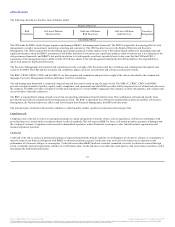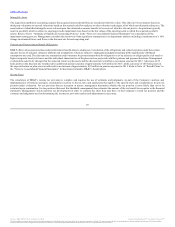BB&T 2014 Annual Report Download - page 78
Download and view the complete annual report
Please find page 78 of the 2014 BB&T annual report below. You can navigate through the pages in the report by either clicking on the pages listed below, or by using the keyword search tool below to find specific information within the annual report.
Table of Contents
Management believes current sources of liquidity are adequate to meet BB&T’s current requirements and plans for continued growth. See Note 5 “Premises
and Equipment,” Note 10 “Long-Term Debt” and Note 15 “Commitments and Contingencies” in the “Notes to Consolidated Financial Statements” for
additional information regarding outstanding balances of sources of liquidity and contractual commitments and obligations.
Contractual Obligations, Commitments, Contingent Liabilities, Off-Balance Sheet Arrangements and Related Party Transactions
The following table presents, as of December 31, 2014, BB&T’s contractual obligations by payment date. The payment amounts represent those amounts
contractually due to the recipient. The table excludes liabilities recorded where management cannot reasonably estimate the timing of any payments that
may be required in connection with these liabilities. Further discussion of the nature of each obligation is included in Note 15 “Commitments and
Contingencies” in the “Notes to Consolidated Financial Statements.”
Long-term debt $ 23,307 $ 1,115 $ 9,491 $ 4,511 $ 8,190
Operating leases 1,464 224 391 297 552
Commitments to fund affordable housing investments 459 236 191 21 11
Private equity commitments (1) 217 58 112 45 2
Time deposits 19,049 11,199 7,013 837 ―
Contractual interest payments (2) 3,916 846 1,208 896 966
Purchase obligations (3) 267 120 105 32 10
Total contractual cash obligations $ 48,679 $ 13,798 $ 18,511 $ 6,639 $ 9,731
(1) Maturities are based on estimated payment dates.
(2) Includes accrued interest, future contractual interest obligations and the impact of hedges used to manage interest rate risk. Variable rate payments are
based upon the rate in effect at December 31, 2014.
(3) Includes purchase obligations for goods and services covered by noncancellable contracts.
The table above excludes the future cash payments associated with the nonqualified pension plans. Refer to Note 14 “Benefit Plans” for information related
to future payments under these plans.
BB&T’s commitments include investments in affordable housing and historic building rehabilitation projects throughout its market area and private equity
funds. Refer to Note 1 “Summary of Significant Accounting Policies” and to Note 15 “Commitments and Contingencies” in the “Notes to Consolidated
Financial Statements” for further discussion of these commitments.
In addition, BB&T enters into derivative contracts to manage various financial risks. A derivative is a financial instrument that derives its cash flows, and
therefore its value, by reference to an underlying instrument, index or referenced interest rate. Derivative contracts are carried at fair value on the
Consolidated Balance Sheets with the fair value representing the net present value of expected future cash receipts or payments based on market interest rates
as of the balance sheet date. Derivative contracts are written in amounts referred to as notional amounts, which only provide the basis for calculating
payments between counterparties and are not a measure of financial risk. Therefore, the derivative liabilities recorded on the balance sheet as of December 31,
2014 do not represent the amounts that may ultimately be paid under these contracts. Further discussion of derivative instruments is included in Note 1
“Summary of Significant Accounting Policies” and Note 19 “Derivative Financial Instruments” in the “Notes to Consolidated Financial Statements.”
In the ordinary course of business, BB&T indemnifies its officers and directors to the fullest extent permitted by law against liabilities arising from litigation.
BB&T also issues standard representation and warranties in underwriting agreements, merger and acquisition agreements, loan sales, brokerage activities and
other similar arrangements. Counterparties in many of these indemnifications provide similar indemnifications to BB&T. Although these agreements often do
not specify limitations, BB&T does not believe that any payments related to these guarantees would materially change the financial condition or results of
operations of BB&T.
77
Source: BB&T CORP, 10-K, February 25, 2015 Powered by Morningstar® Document Research℠
The information contained herein may not be copied, adapted or distributed and is not warranted to be accurate, complete or timely. The user assumes all risks for any damages or losses arising from any use of this information,
except to the extent such damages or losses cannot be limited or excluded by applicable law. Past financial performance is no guarantee of future results.
























